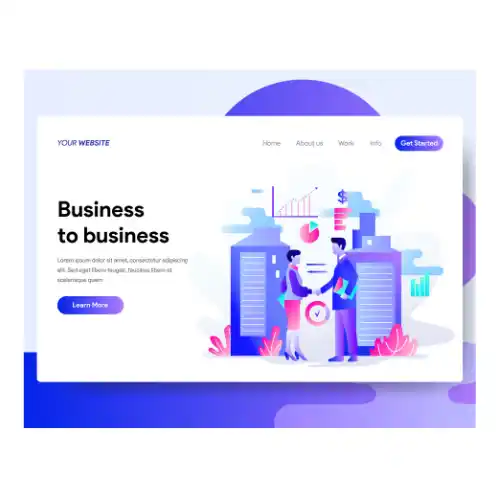This blog aims to help you gain an understanding of everything B2B copywriting entails, how it is different from all other forms of copywriting and everything else you might have wondered with regard to B2B copywriting. So brace yourselves and get started with a clean slate state of mind so that you get the best out of this blog.
What the Chaos Is All About

First of all, what is copywriting? We often hear the word float around but unless one has really bothered to find out, most do not know what exactly copywriting is.
Well, copywriting is basically a persuasive form of writing content that includes informative and promotional materials curated with an intention of pushing readers to take some call to action. You might have noticed links that lead you to a webpage collecting your details to keep you in the loop for further updates or one that leads you to a shopping website. Now these are designed keeping the “call to action” in mind.
This kind of copywriting becomes one of B2C or business-to-client marketing. There are different kinds of copywriting like sales copy, web copy, technical, PR etc. Each one of these is designed to suit the target audience of the particular copy type, among which B2B or business-to-business copywriting is one.
So, what is B2B copywriting and how is it different from the usual copies? Of course the target audiences for the two are different but what else?
B2B copywriting includes content specific to a company that is designed to convey valuable information about its services and itself to other companies. Now although both B2B and B2C copies are curated with the intention of making sales, there are some challenges that B2B copy involves that is unique to it.
Common Practices Must For A Copywriter?

Below are some common practices that a copywriter needs to develop while working on a B2B project:
1. Gathering Information

Working with two parties always involves this basic rule. Knowing what the other person wants, what they expect, their goals, their target markets etc.. It is a crucial first step to know that you are headed in the right direction with your copy. Two companies belonging to the same niche might not want the same thing. So, understanding your client and gathering the right and necessary information is an absolute must.
Never make the mistake of having half knowledge or making assumptions based on what you already know. Always ask! Being on the same page with your client is extremely important.
Some things like knowing where they were before you, where they are now and where they are headed will help you build a rough picture in your head. Understanding their challenges will help you create better copies.
2. Tone of Copy
While writing copies for a B2C project, a lighter tone works great. It is like making quite an informal conversation with the customers and mostly they will take action based on their instinct, needs and emotions. So engaging and light-hearted conversational tone is more the one to go to!
In B2B, a more professional tone is a necessity. It must focus on the growth of business and highlight the benefits, technical specifications and approach the central idea with logic rather than just being conversational. That said, ensure that it is not completely devoid of basic warmth or empathy. A good example to understand this would be the infosys website, it encapsulates the idea perfectly in terms of tonality and language used.
The customers in a B2B setup are investing time, capital and energy in this service/product. So, catering to their needs and highlighting the right information in a precise manner is the best way to do it.
3. Appeal
In a B2C environment, you are most often speaking to one person. Writing in a way that appeals to the one person involved in the transaction works great!
Adapting an emotional tone and appeal helps resonate with the potential customer in a one-person transaction environment. But that need not be the case with B2B all the time.
In a B2B environment, often different groups of people are involved. As another business looking to make an investment, different departments are involved in the process of coming to a consensus. Likewise, customizing the style of writing in a way that captures the attention and appeals to different kinds of people is indispensable.
Like, including several diverse talking points is one of the effective ways to do it. You may incorporate other ways that work in favour of the client.
4. Adapt and Align

You may have handled a ton of similar projects, but the wise thing to do would be to pretend to be new and just follow the client’s lead. While you know what kind of copy works best, only the client is aware of what is best for their company and what they want.
So, be a listener, ask relevant questions, learn the industry terms unique or frequently used by this particular client. Stalk their websites and brochures! Study how often they are used and keep working on the copy according to the client’s instructions until the final draft.
Yes, we hear you, your head is overflowing with various ideas but unfortunately, B2B copywriting projects allow very little to no space for experiments.
Using their previously used copies as references can go a long way in figuring out what exactly you need to curate while helping the client themselves understand what they desire as well!
It often happens that the clients may not have realized what they did not like/work in the previous copy as well. This discussion and reference will help both parties bring their best to the fore.
5. Communication is Key

Communicating with your client goes a long way in helping the project progress smoothly. It includes not just aspects like discussing the client’s goals but also payments and feedback.
At every phase of completion, going back and forth with the client reviewing it can help eliminate flaws, confusion and assumptions. This helps streamline the progress while helping you meet the client’s requirements to the T.
This process helps even more if you are working with this client for the first time. You will be saving each other a lot of time with the feedback so that both of you know precisely what you can expect.
What’s Common Between B2B and B2C?
(couldn’t find a vector image to represent similarity)
Some similarities between B2B and B2C copies are that
Both of them need thorough and extensive research about the service/product. That is integral to copywriting irrespective of whether you are writing it for another business or a customer.
Both copies intend to convert their readers and users to customers. The only difference is that in a B2B setting, one is trying to convince a whole system of people while in B2C, you are talking to a single customer.
Another similarity worth noting might be the fact that, in both models, the potential customer is most often aware of the product and its uses/applications. The job of a copywriter is to persuade the potential customers into actually buying the product. To make them feel and understand that this is the product they were looking for, one that will satisfy their intent.
Doing so in an educational manner so that they make sound decisions is an effective way to do it. That is the job of the copy, to be persuasive, authentic and credible, helping build a customer base that is loyal and to satisfy the user intent in order to keep them hooked.
Whatever the differences might be, both sales models will be impacted simultaneously and mostly similarly with the ever-evolving digital media marketing and rapidly changing consumer behavior. It is only wise for copywriters to stay in touch with the latest trends and adapt to new and effective ways of copywriting with changing times.
Some Examples of B2B Copywriting
If you are acquainted with the field of advertising even remotely, you possibly know of David Oglivy. The guy who is considered the Father of Modern Advertising. Now why is this guy famous? What is so special about his advertising you ask. Well, here’s a popular example!
The 1958 ad that was part of Rolls-Royce print campaign saw a copy that read – “At 60 miles an hour, the loudest noise in this new Rolls-Royce comes from the electric clock.” Written by David Oglivy, this copy speaks volumes about why it is a good copy, apart from the fact that it garnered the appreciation and praise of several big names.
The man could have simply said something along the lines of, this car is the quietest you’ve seen or known. But his words “60 miles an hour” help you picture the car zooming with the engine sound normally. And then he says, “..the electric clock”, which helps you imagine the sound of a ticking clock that you only ever hear when there’s absolute silence.
Now THIS is an ad that you will remember because of the words and phrases that are used to describe the car model. Because the mental image you had when you read it stays with you and helps foster your curiosity to know about this product. THAT is good copywriting! One that sticks with your users and helps them convert into potential customers. These are also sometimes described as “sticky”.
You can browse a few popular websites that you are familiar with that cater to businesses that need their services. For example, studying the pages of WeTransfer, Canva, Mailchimp or other giants that you might know of, will expose you to the kind of language they use.
Some cheeky while some serious, all of them aim at best representing their brand and reinforcing their idea in the minds of users.
Clarity in conveying the message is extremely important. While some of the above examples use simple language that is easy to understand, some are creative allowing the users to feel like a part of the community quickly. Some use “sticky” terms that are reflected in every part of their copy helping the users realise how good an experience they assure the customers are promised.
In a Nutshell
As a B2B copywriter, you are the means for your clients to reach their target audience through words. And words you choose can make or break the copy. It is the fuel that keeps the entire process going. In both cases (B2C and B2B), potential customers are reading the content you curate. That is the one thing that companies have to keep people involved and in the loop. This makes it crucial that your content satisfies what the users are looking for as a B2B copywriter.
They have the tools to understand what their audience wants and you have the power of communication AND tools. What’s stopping you from creating the perfect B2B copy, right?
Let us know if this provided some insight and some tips you use that have helped you improve your copy skills.






